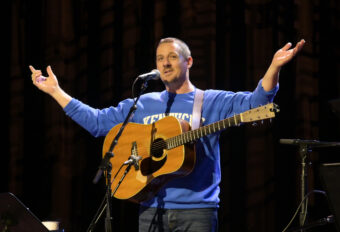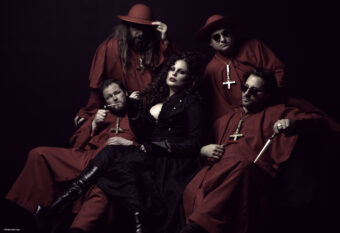SSSSKKKCCCCH. Sssskch, sssskch. SSSSSSSSSSKKKCCH. A harsh, crisp screech bounces off the century-old brick walls in a cavernous former textile mill in Providence, Rhode Island, as Brian Chippendale walks through the loft he shares with seven other artists and musicians. Divided by cloth curtains, piles of rusted BMX bikes, and giant furry-alien statues, the place is a honeycomb of creative activity: There’s somebody over there sketching on a pad, somebody moving canvases around, somebody noisily spraying water over a silk screen in an industrial-size sink.
Chippendale-a lanky guy dressed in holey, rag-ready pants-stands in front of a table stacked high with his hand-printed comic books. Opening a window, he gazes out at another empty-looking factory beside a sludgy, brown-black creek. “It’s actually kind of beautiful, isn’t it?” he says, smiling.
For Chippendale and Brian Gibson, his partner in the band Lightning Bolt, this scene of energized clutter and muck perfectly reflects the joyously clamorous, no-rules freak-out of their music. With Chippendale on drums and vocals and Gibson on bass, Lightning Bolt are a product of intense artistic collaborationand crack-up-your-friends performance art. They’re also the key players in underground rock’s most exciting, and challenging, incarnation-noise punk.
And they’ve got plenty of company. Late last year, Wolf Eyes, a Michigan three-piece whose brand of noise employs feedback and dense electronic drones, signed to venerable indie-rock label Sub Pop, and this year were invited to join the ill-fated Lollapalooza tour. (After it was canceled, they played two weeks of make-up dates with fans Sonic Youth.) Groundbreaking San Diego crazies the Locust and Seattle’s Blood Brothers have signed to major indies Epitaph and V2, respectively. Festivals like No Fun in New York and Minneapolis’ Destijl/Freedom From have drawn larger crowds than anybody thought possible given these bands’ often room-clearing early shows.
In fact, a whole generation of innovative noise-punk groups is springing up across the country. In Providence, the cradle of neo-noise, one-man sound terrorists Prurient and Kites play alongside more traditional (but no less chaotic and skronky) groups Mahi Mahi and Daughters. In Michigan, party athlete Andrew W.K. began his career as part of the Bulb Records family, which includes Wolf Eyes, 25 Suaves, and Hair Police (who are originally from Kentucky). In New York, the scene is huge, with longtime knob-riders Black Dice, brainy laptop jammer and No Fun Fest mastermind Carlos Giffoni, Sightings, Double Leopards, and the band that might be the new Lightning Bolt: Mouthus, a duo that melds thuddy, electronically damaged drums, deeply detuned guitar, and guttural lion’s-roar vocals.
“This is as incredible as anything I’ve ever heard since going to see groups in 1976,” says Thurston Moore of Sonic Youth, a longtime scene booster, who has talked up many of the bands in a column he cowrites for Arthurmagazine. “This is as heavy as an early Ramones gig, as heavy as when [experimental guitarist and composer] Glenn Branca was really in his prime.” Though its origins lie in the ’70s proto-industrial grind of London’s Throbbing Gristle and the sonic assault of ’80s and ’90s Japanese noisemongers like Merzbow and the Boredoms, today’s noise punk developed largely as party music. In 1995, Chippendale and some friends from the Rhode Island School of Design-including Mat Brinkman of the art collective Forcefield, who were featured in the Whitney Museum’s 2002 Biennial-moved into an old mill and named it Fort Thunder. They covered every inch of the space with their art. Sculpture and found objects literally became the walls.
“Suddenly, there were people everywhere,” Chippendale says. “It was really cheap, there was tons of space, and you could be as loud as you wanted. Nobody gave a shit. We practiced all the time, had parties and shows all the time. It was a really wide and free and creative place.”
The scene was full of unbridled, childlike enthusiasm. Chippendale’s art, which can be seen on each Lightning Bolt release, is noise punk in color: explosions of paint, with smiling cartoon characters peeking out everywhere. His comic, Ninja, has featured his childhood drawings up to more recent artwork; it’s sometimes hard to tell which is which.
“I thought of Fort Thunder as the future,” says Gibson, the painfully shy but gifted bassist whose throbbing, whistling tones are the wings of Lightning Bolt’s sound. “It was a model that was destined to be repeated. It was this seed that was planted and was going to spread. But right before it got to the point where it was going to be germinated, it got bulldozed.” Fort Thunder was shut down in 2001, and its former space is now home to a Staples and a parking lot.
But before the end, the Fort’s cacophonous childhood id run amok blossomed into Lightning Bolt. On its three albums for Providence’s Load Records-which is to noise punk what Sub Pop was to grunge-the band has built a howling catharsis out of short rhythmic and melodic patterns that can sound like a spaceship taking off or a baby monster playing with a malfunctioning electronic toy. Prog-rock nut Gibson tickles his strings until Chippendale, building up a twitchy pulse on his scrappy, unorthodox drum set, pushes the action forward with madman rolls, creating, as they say, “noisy, muddy waves-just loud as shit.”
Gibson and Chippendale, whose first show together was way back in 1994 at RISD, quickly learned how to set themselves apart. “You make it more raw and unwieldy and aggressive and everyone totally goes for it,” says Chippendale.
And so that’s just what they did.
While Lightning Bolt were cranking up in Rhode Island, Wolf Eyes were forming in Ann Arbor, Michigan. Sharing vocal and instrumental duties, Nathan Young, Aaron Dilloway, and John Olson linked Detroit’s twin heritages of gritty garage rock and moody techno with a healthy dose of punk abandon. The result-for a brief time known by the unfortunate term “garbagetronica”-is a wailing, tortured dungeon sound, with slow, rumbling rock chords pounding like a repressed memory. Inside, as if trapped, are hoarse, angry, crying voices.
And yet it’s a party for Wolf Eyes too.
“We’re good-time boys,” Olson says in a salt-of-the-earth Midwestern accent. “We could be intellectuals, breaking down everything we do, but we don’t really dig talking about shit like that. We’re like, ‘Dude, that rules-give me another slice of pizza.'”
The band, founded by Young in 1996, rehearses in a space above VG Kids, a silk-screening shop in Ypsilanti, Michigan, where Olson works alongside Pete Larson, who runs Bulb Records and plays in 25 Suaves. (Young builds barns with his father; Dilloway works at a local record store.) Wolf Eyes’ output is immense: In addition to their Sub Pop debut, Burned Mind, they’ve recorded all their practices, and between Dilloway’s Hanson label and Olson’s American Tapes, they’ve released hundreds of cassettes and CD-Rs. VG Kids, like Fort Thunder, serves as the band’s business headquarters and boys’-club treehouse, where somebody is always ripping on somebody else’s choice of foreign-language cult rock. Think Jack Black and John Cusack in High Fidelity, debating Faust and Neu! instead of Radiohead and the Clash.
Dilloway facetiously describes the Wolf Eyes sound as “average rock,” and onstage the band does in fact carry on somewhat like a pissed-off, oversexed rock band. Shirts come off and bottles of Bud are close by. Andrew W.K. describes Young’s moves as “passionate and grandiose, like he’s pleading. Anyone who sees it is very moved by it.”
Historically, noise music has been narrow in sound and appeal, and the genre’s biggest American names over the years-Swans, Live Skull, Unsane, Cop Shoot Cop-have been stiff and a bit humorless. But the new noise groups have varied their attitude and style. Goofballs and practical jokers rule: The Locust, Lightning Bolt, Pink and Brown, and others ham it up by wearing absurd homemade masks and costumes.
Lightning Bolt are especially unconventional live. They set up on the floor of a venue, off to the side or even smack in the middle of the audience, surprising the hell out of everybody by blasting off immediately after other bands’ sets end. “There are clubs where you’ve gone to 100 shows, and you’ve got this weird amalgamated memory of them,” Chippendale says. “When we come in and play, we carve out a new memory. It makes it more unique-like, ‘There was this one Lightning Bolt show where I had to swivel my head.'”
When Lightning Bolt, the Locust, and the now-defunct Arab on Radar led the Oops! Tour in 2002, it was a defining moment for the noise-punk scene, primarily because it pulled from so many corners of the punk/hardcore/noise universe: Blood Brothers, Erase Errata, the Flying Luttenbachers, and Orthrelm. The bands had already established friendships and released records on each other’s labels, but for the first time, they presented a unified front. After a decade of punk and emo courting the pop charts, this was a new breed.
“Noise has taken the place of punk rock,” says Thurston Moore. “People who play noise have no real aspirations to being part of the mainstream culture. Punk has been co-opted, and this subterranean noise music and the avant-garde folk scene have replaced it.”
Inevitably, the scene has had modest financial success-each Lightning Bolt album, among the genre’s best-selling, moves less than 20,000 copies. The most prominent related act is major-label prog-punk outfit the Mars Volta, whose Cedric Bixler Zavala and Omar Rodriguez-Lopez toured with the Locust (as members of At the Drive-In). Rodriguez’s Gold Standard Laboratories label has released records by several noise-punk bands. Still, most of the players are shocked by the adulation they’ve experienced so far. Aaron Warren, who plays bass and electronics in Brooklyn’s Black Dice, said he could hardly believe the response they got at this year’s All Tomorrow’s Parties festival in England. “It felt like we were living in the future,” he said. “Thousands of kids were listening to, and enjoying, high-pitched feedback not even made by guitars-just feedback.”
As to why kids might be digging such extreme sounds, Mike Connelly of Hair Police has a theory: “Basically, people are bored. It used to be that if you were into hardcore music, that was a risk. People were not into you if you were into Black Flag. But now, it’s safe to be into punk. If you want to piss off your parents, put on Hair Police.”
Blood Brothers, five guys from suburban Seattle who are so skinny they look like aliens, are about as popular as a band in the noise-punk scene can be: Signed to V2 (home of the White Stripes), they just released their fourth album, Crimes. Known for the intense double-scream attack of vocalists Jordan Blilie and Johnny Whitney, the band create a visceral, infectious blare. Like their progenitors the Locust, Blood Brothers turn Lightning Bolt’s approach on its head: Instead of loose, diffuse jams, they offer tightly orchestrated bursts of aggression. “Noise” doesn’t begin to describe their sound.
Morgan Henderson, the Blood Brothers’ soft-spoken, ruminative bassist, thinks the very term is inherently dismissive. “You might as well be saying, ‘I don’t understand it.’ When [free-jazz pioneer] Ornette Coleman played, people were like, ‘This is fucking noise.’ But to him and Don Cherry and Charlie Haden and Ed Blackwell, they knew exactly what was going on.It wasn’t noise to them.”
Wolf Eyes’ Aaron Dilloway agrees.”Noise means something you don’t want to hear,” he says.”It means unorganized sound, like a blanket over you that’s meant to allow no interaction at all.But for us, it’s totally natural and all about human interaction. I truly think these are good sounds.Nothing else sounds good to me.”




